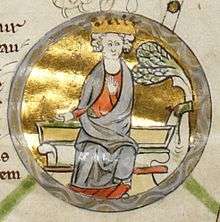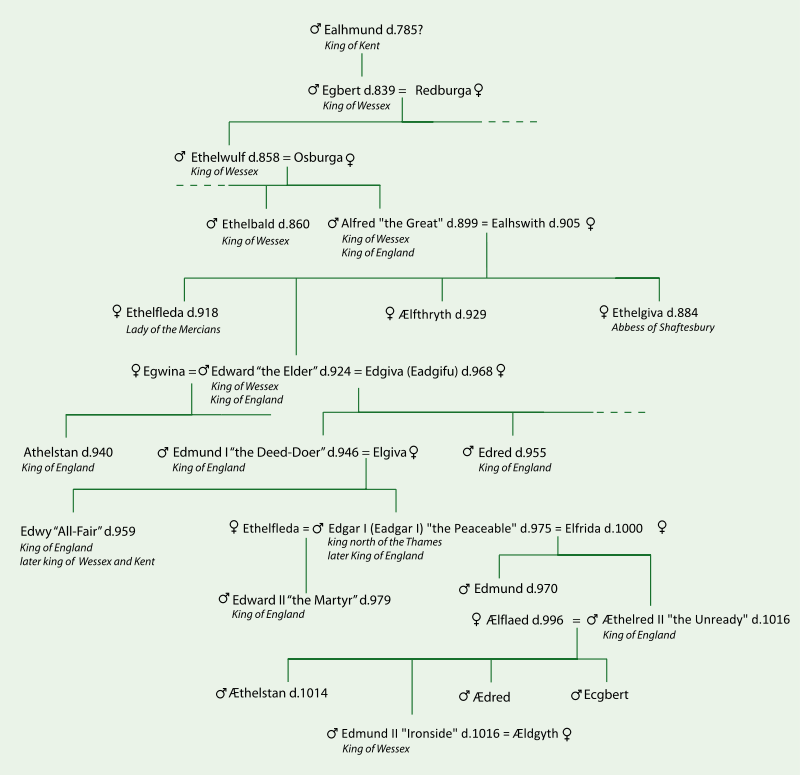Edmund I
| Edmund | |
|---|---|
 Edmund in the late thirteenth century Genealogical Chronicle of the English Kings | |
| King of the English | |
| Tenure | 27 October 939 – 26 May 946 |
| Coronation |
c.29 November 939 probably at Kingston upon Thames[1] |
| Predecessor | Æthelstan |
| Successor | Eadred |
| Born |
921 Wessex, England |
| Died |
26 May 946 (aged 24–25) Pucklechurch, Gloucestershire, England |
| Burial | Glastonbury Abbey |
| Spouse |
Ælfgifu of Shaftesbury Æthelflæd of Damerham |
| Issue |
Eadwig, King of England Edgar, King of England |
| House | Wessex |
| Father | Edward, King of Wessex |
| Mother | Eadgifu of Kent |
| Religion | Roman Catholic |
Edmund I (Old English: Ēadmund, pronunced [æːɑdmund]; 921 – 26 May 946), called the Elder, the Deed-doer, the Just, or the Magnificent, was King of the English from 939 until his death. He was a son of Edward the Elder and half-brother of Æthelstan. Æthelstan died on 27 October 939, and Edmund succeeded him as king.
Military threats
Edmund came to the throne as the son of Edward the Elder,[2] grandson of Alfred the Great, great-grandson of Æthelwulf of Wessex, great-great grandson of Egbert of Wessex and great-great-great grandson of Ealhmund of Kent. Shortly after his proclamation as king, he had to face several military threats. King Olaf III Guthfrithson conquered Northumbria and invaded the Midlands; when Olaf died in 942, Edmund reconquered the Midlands.[2] In 943, Edmund became the god-father of King Olaf of York. In 944, Edmund was successful in reconquering Northumbria.[3] In the same year, his ally Olaf of York lost his throne and left for Dublin in Ireland. Olaf became the king of Dublin as Amlaíb Cuarán and continued to be allied to his god-father. In 945, Edmund conquered Strathclyde but ceded the territory to King Malcolm I of Scotland in exchange for a treaty of mutual military support.[3] Edmund thus established a policy of safe borders and peaceful relationships with Scotland. During his reign, the revival of monasteries in England began.
Louis IV of France
_obverse.jpg)
One of Edmund's last political movements of which there is some knowledge is his role in the restoration of Louis IV of France to the throne. Louis, son of Charles the Simple and Edmund's half-sister Eadgifu, had resided at the West-Saxon court for some time until 936, when he returned to be crowned King of France. In the summer of 945, he was captured by the Norsemen of Rouen and subsequently released to Duke Hugh the Great, who held him in custody. The chronicler Richerus claims that Eadgifu wrote letters both to Edmund and to Otto I, Holy Roman Emperor in which she requested support for her son. Edmund responded to her plea by sending angry threats to Hugh.[4] Flodoard's Annales, one of Richerus' sources, report:
Edmund, king of the English, sent messengers to Duke Hugh about the restoration of King Louis, and the duke accordingly made a public agreement with his nephews and other leading men of his kingdom. [...] Hugh, duke of the Franks, allying himself with Hugh the Black, son of Richard, and the other leading men of the kingdom, restored to the kingdom King Louis.[5][6]
Death and succession
On 26 May 946, Edmund was murdered by Leofa, an exiled thief, while attending St Augustine's Day mass in Pucklechurch (South Gloucestershire).[7] John of Worcester and William of Malmesbury add some lively detail by suggesting that Edmund had been feasting with his nobles, when he spotted Leofa in the crowd. He attacked the intruder in person, but in the event, Leofa killed him. Leofa was killed on the spot by those present.[8] A recent article re-examines Edmund's death and dismisses the later chronicle accounts as fiction. It suggests the king was the victim of a political assassination.[9]
Edmund's sister Eadgyth, the wife of Otto I, Holy Roman Emperor, died earlier the same year, as Flodoard's Annales for 946 report.[10]
Edmund was succeeded as king by his brother Eadred, king from 946 until 955. Edmund's sons later ruled England as:
- Eadwig, King of England from 955 until 957, king of only Wessex and Kent from 957 until his death on 1 October 959.
- Edgar the Peaceful, king of Mercia and Northumbria from 957 until his brother's death in 959, then king of England from 959 until 975.
Ancestry
| Ancestors of Edmund I of England | |||||||||||||||||||||||||||||||||||||||||||||||||||||||||||||||||||||||||||||||||||||||||||||||||||||||||||||||||||||||||||||||||||||||||||||||||||||||||||||||||||||||||||||||||||||||||||||||||||||||||||||||||||||||||||||||||||||||||||||||||||||||||||||||||||||||||||||
|---|---|---|---|---|---|---|---|---|---|---|---|---|---|---|---|---|---|---|---|---|---|---|---|---|---|---|---|---|---|---|---|---|---|---|---|---|---|---|---|---|---|---|---|---|---|---|---|---|---|---|---|---|---|---|---|---|---|---|---|---|---|---|---|---|---|---|---|---|---|---|---|---|---|---|---|---|---|---|---|---|---|---|---|---|---|---|---|---|---|---|---|---|---|---|---|---|---|---|---|---|---|---|---|---|---|---|---|---|---|---|---|---|---|---|---|---|---|---|---|---|---|---|---|---|---|---|---|---|---|---|---|---|---|---|---|---|---|---|---|---|---|---|---|---|---|---|---|---|---|---|---|---|---|---|---|---|---|---|---|---|---|---|---|---|---|---|---|---|---|---|---|---|---|---|---|---|---|---|---|---|---|---|---|---|---|---|---|---|---|---|---|---|---|---|---|---|---|---|---|---|---|---|---|---|---|---|---|---|---|---|---|---|---|---|---|---|---|---|---|---|---|---|---|---|---|---|---|---|---|---|---|---|---|---|---|---|---|---|---|---|---|---|---|---|---|---|---|---|---|---|---|---|---|---|---|---|---|---|---|---|---|---|---|---|---|---|---|---|---|
 Diagram based on the information found on Wikipedia
| |||||||||||||||||||||||||||||||||||||||||||||||||||||||||||||||||||||||||||||||||||||||||||||||||||||||||||||||||||||||||||||||||||||||||||||||||||||||||||||||||||||||||||||||||||||||||||||||||||||||||||||||||||||||||||||||||||||||||||||||||||||||||||||||||||||||||||||
See also
- Ælfgifu of Shaftesbury
- Burial places of British royalty
- Edmund the Just, fictional king of Narnia
Notes
- ↑ The Blackwell Encyclopedia of Anglo-Saxon England, p. 514
- 1 2 Edmund I (king of England), "Edmund-I" Encyclopædia Britannica
- 1 2 David Nash Ford, Edmund the Magnificent, King of the English (AD 921-946), Early British Kingdoms.
- ↑ Richerus, Historiae, Book 2, chapters 49–50. See MGH online.
- ↑ Dorothy Whitelock (tr.), English Historical Documents c. 500–1042. 2nd ed. London, 1979. p. 345.
- ↑ Edmundus, Anglorum rex, legatos ad Hugonem principem pro restitutione Ludowici regis dirigit: et idem princeps proinde conventus publicos eumnepotibus suis aliisque regni primatibus agit. [...] Hugo, dux Francorum, ascito secum Hugo Nneigro, filio Richardi, ceterisque regni primatibus Ludowicum regem, [...] in regnum restituit. (Flodoard, Annales 946.)
- ↑ "Here King Edmund died on St Augustine’s Day [26 May]. It was widely known how he ended his days, that Liofa stabbed him at Pucklechurch. And Æthelflæd of Damerham, daughter of Ealdorman Ælfgar, was then his queen." Anglo-Saxon Chronicle, MS D, tr. Michael Swanton.
- ↑ John of Worcester, Chronicon AD 946; William of Malmesbury, Gesta regum, book 2, chapter 144. The description of the circumstances remained a popular feature in medieval chronicles, such as Higden's Polychronicon: "But William, libro ij° de Regibus, seyth (says) that this kyng kepyng a feste at Pulkirchirche, in the feste of seynte Austyn, and seyng a thefe, Leof by name, sytte [th]er amonge hys gestes, whom he hade made blynde afore for his trespasses – (quem rex prios propter scelera eliminaverat, whom the King previously due to his crimes did excile) – , arysede (arrested) from the table, and takenge that man by the heire of the hedde, caste him unto the grownde. Whiche kynge was sleyn – (sed nebulonis arcano evisceratus est) – with a lyttle knyfe the [th]e man hade in his honde [hand]; and also he hurte mony men soore with the same knyfe; neverthelesse he was kytte (cut) at the laste into smalle partes by men longyng to the kynge." Polychronicon, 1527. See Google Books
- ↑ K. Halloran, A Murder at Pucklechurch: The Death of King Edmund, 26 May 946. Midland History, Volume 40, Issue 1 (Spring 2015), pp. 120-129.
- ↑ Edmundus rex Transmarinus defungitur, uxor quoque regis Othonis, soror ipsius Edmundi, decessit. "Edmund, king across the sea, died, and the wife of King Otto, sister of the same Edmund, died also." (tr. Dorothy Whitelock, English Historical Documents c. 500–1042. 2nd ed. London, 1979. p. 345).
References
- Flodoard, Annales, ed. Philippe Lauer, Les Annales de Flodoard. Collection des textes pour servir à l'étude et à l'enseignement de l'histoire 39. Paris: Picard, 1905.
External links
| Wikisource has original works written by or about: Edmund I |
| Wikimedia Commons has media related to Edmund I of England. |
| Regnal titles | ||
|---|---|---|
| Preceded by Æthelstan |
King of the English 939–946 |
Succeeded by Eadred |